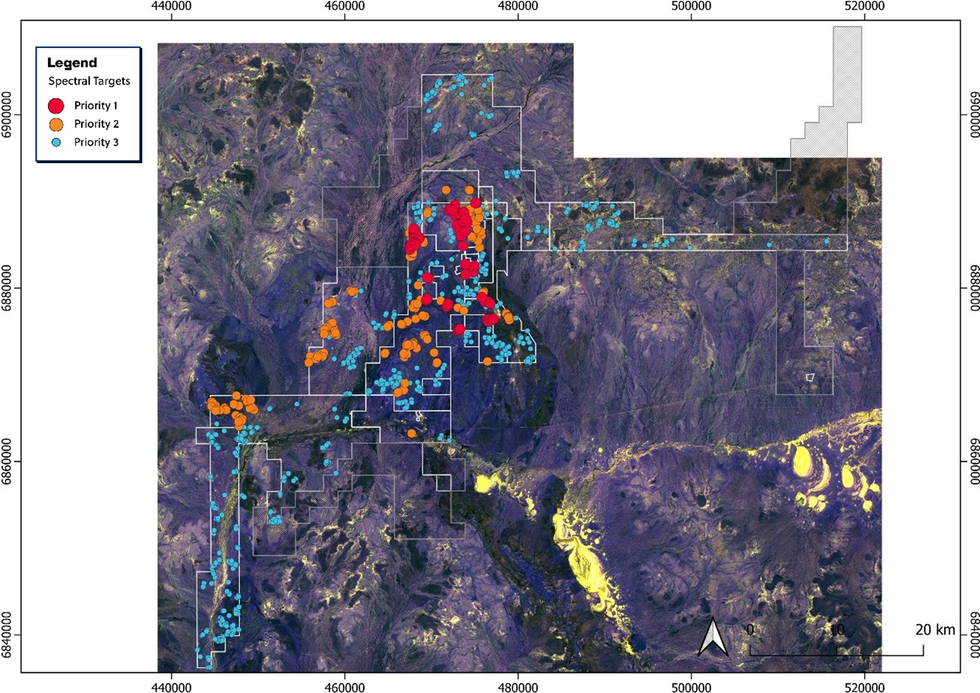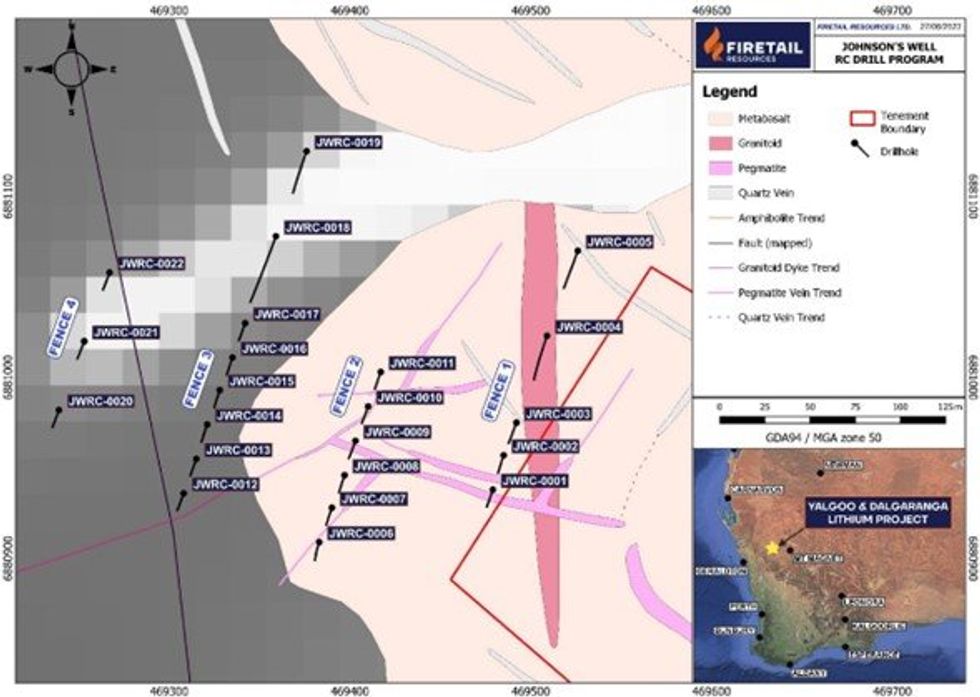
November 28, 2023
Australian battery minerals explorer Firetail Resources Limited ("Firetail" or "the Company") (ASX: FTL) is pleased to provide an update on exploration activities at its Yalgoo Lithium Project ("Yalgoo") in Western Australia.
A review and interpretation of remote sensing data, which has been integrated with a new geophysical interpretation of the area, has identified a number of new potential Lithium- Caesium-Tantalum (“LCT”) pegmatite targets for on-ground follow-up.
Highlights include:
- Analysis of hyperspectral imagery has identified numerous potential new lithium-bearing pegmatites at the Yalgoo Lithium Project.
- Known lithium pegmatites within the project area were used as a reference for identifying additional potential lithium pegmatites.
- Generative work also included a review and interpretation of open file geophysics from Yalgoo Project area.
- Ground truthing, mapping and rock chip sampling of new targets to commence this week
- Similar work program now underway for Dalgaranga Project, with historical data compilation already completed.
- Follow-up drilling planned for Yalgoo region in the first quarter of 2024
- Firetail is committed to exploration in the under-explored Mid-West region of Western Australia, where industry peers have identified critical minerals systems proximate to the FTL tenure.
Executive Chairman, Brett Grosvenor, commented:
“Whilst the drilling campaign at Picha has been the recent focus for the FTL team, we remain committed to progressing exploration across the Yalgoo and Dalgaranga Projects, as we have growing confidence that this region and is primed for a significant discovery of critical minerals.
“The previously under-explored Mid-West region of WA is undergoing a period of growing exploration activity. Industry peers have increased their focus in the region with critical minerals systems defined by Krakatoa Resources1 (ASX:KTA) and Aldoro Resources2 (ASX:ARN) at their neighbouring projects.
“Our systematic approach to exploration at Yalgoo and Dalgaranga has enabled FTL to effectively deploy funds with a targeted approach, with the potential to start a more significant drilling program in the first quarter of 2024 across this highly prospective tenure.”
Yalgoo Lithium Project
Hyperspectral data interpretation
Hyperspectral data over the Yalgoo Lithium Project has been acquired, processed and interpreted by the exploration consulting group Terra Resources (“Terra”). This data has also been intergrated with an interpretation of open file geophysical data over the Project area. Sentinel-2 and ASTER data were processed and imaged to highlight potential lithium-bearing pegmatites. Known lithium bearing pegmatites in the region were used to characterise the spectral signature and inform the process of identifying targets for on-ground follow-up.
A Sentinel-2 composite image was primarily used to target pegmatites, with ASTER imagery used to generate additional targets. Satellite imagery and geology were also used to assist in the targeting and to help prioritise targets. Numerous targets were identified and have been prioritised, in part according to the geological setting in relation to the typical geological setting for LCT pegmatites (refer to Figure 1 for targets).
Ground-truthing of these targets is now required, which will comprise geological mapping and rock chip sampling. Some of the targets have been discounted as they have been sampled in previous Firetail exploration programs, however a number of new areas remain untested. The initial focus will be on the Priority 1 and 2 targets only. High priority target locations tend to cluster in particular areas as shown by the cluster of Prioirty 1 targets in the north and central areas.

Johnson Well Prospect
An RC drilling program was completed at the Yalgoo Project, Johnson Well Prospect in June 2023, following up from geological mapping and rock chip sampling3. The drilling program comprised 22 holes for 589m with drilling completed on four traverses approximately 80m apart and drill holes 20m or 40m apart (refer to Figure 2).
Three of the four drill traverses intersected pegmatites indicating continuity over a strike length of at least 150m and also open down-dip.
Assay results2 confirmed the pegmatites intersected are Lithium-Caesium-Tantalum (LCT) pegmatites, with a best result of 3m @ 0.83% Li2O from 32m in JWRC-0005 including 1m @ 1.16% Li2O from 34m. Lithium minerals observed in the pegmatites were predominantly lepidolite and zinnwaldite, associated with potassium feldspar, albite, muscovite and biotite.
Further drilling is planned for early 2024 to test the down-dip extension of this mineralisation, with drill-holes planned to step-out to the northeast.

Dalgaranga Project
Generative exploration work has commenced on the Dalgaranga Lithium Project located just north of the Yalgoo Lithium Project and just to the south of the historical Dalgaranga Tantalum mine. A rigorous historical data compilation has been completed which has indicated several intersections of pegmatites in historical drill holes. These drill hole locations require initial on- ground follow-up to check for any outcropping pegmatites.
Hyperspectral data analysis and interpretation will be completed for the Dalgaranga Project in the coming weeks. This data will be integrated with a new interpretation of open file geophysical data to highlight potential lithium-bearing pegmatites. This will be followed up with ground truthing and rock chip sampling of any outcropping pegmatites.
Click here for the full ASX Release
This article includes content from Firetail Resources Limited, licensed for the purpose of publishing on Investing News Australia. This article does not constitute financial product advice. It is your responsibility to perform proper due diligence before acting upon any information provided here. Please refer to our full disclaimer here.
FTL:AU
The Conversation (0)
Latest News
Latest Press Releases
Related News
TOP STOCKS
American Battery4.030.24
Aion Therapeutic0.10-0.01
Cybin Corp2.140.00